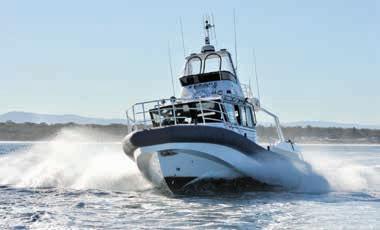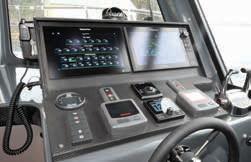
3 minute read
Newest superboat a 'vessel for the future'
Jervis Bay 41 builder challenged to think outside the box, push boundaries.
The delivery of the latest superboat in the MRNSW fleet has provided the Jervis Bay boating community with a next generation rescue vessel ready to respond to emergencies now and for many years to come.
The brief for the build of the new Jervis Bay 41 had been simple: MRNSW challenged Harwood Marine General Manager Giovanni Cervella to look outside the box and push the boundaries by developing a vessel for the future.
After nearly two years of planning, consultation and construction, the $850,000 13.5 metre monohull recently made its debut on the bay’s sparkling waters, ready for a Covidsafe introduction to its new crew members.
MRNSW Fleet Manager Kelvin Parkin said the delivery of a safe vessel with a long operational life able to meet the demanding operating conditions in the bay and offshore had been paramount.
“As our Jervis Bay unit works closely with the naval base at HMAS Creswell, we needed a vessel that could not only quickly and safely respond to emergencies in the worst of weather conditions but also reliably support the Navy’s exercises,” Mr Parkin said. “Critical in the build process was working with our volunteer members and challenging their thinking on what a rescue boat should look like. The outstanding result speaks for itself.”
JB 41’s varied hull, stepped bow and fine entry point enable it to tackle heavy seas forward while also reducing the risk of broaching in a following sea. This different set up allows a very dry ride even in heavy seas and provides a solid operational platform in the most trying of conditions.
The boat has a number of interesting features, including a specially designed hydraulic heavy lift platform which drops below the waterline to assist in disembarking passengers and loading heavy equipment, along with a carbon fibre lifting davit with sockets both port and starboard as well as on the fly bridge. The deck area features a roll away tow line and roaming bilge pump system.
Mr Parkin said that the internal fit out had been carefully planned with high grade ergonomic seating, a stable internal workspace to lay out charts and grab rails for extended search and rescue operations.
“We created a massive amount of storage space below deck which can be accessed from the internal cabin floor, in which is kept the davit, stretchers and large fenders,” he said. “The finished internal fit out is a mix of carbon fibre, fibreglass and alloy, giving the boat a highstandard yet industrial feel. The result is a workspace that is not just efficient but maximises volunteer comfort, helping to reduce fatigue and enabling crew to safely operate out on the water for longer.”
As with other MRNSW vessels, JB 41 is fitted with a full Raymarine electronics suite with customised digital switching working from four stations including the fly bridge. With 16 inch multifunction displays, radio direction finder, FLIR camera and two loud hailers, the vessel is set up to quickly locate vessels in trouble when vital seconds count.
Powered by twin Yanmar 6LY engines that put out a combined 900 Horsepower, the boat can comfortably cruise at 20 knots with a maximum speed of 30 knots. This is augmented by Veem Props in a rolled tunnel giving a high torque drive and a ZipWake ride control system.
Commissioner Stacey Tannos said one of the best aspects of the build was that it was completed in NSW, maintaining Marine Rescue’s commitment to source boats locally and support local jobs and industry.
“Our organisation is built on community based volunteers and in sourcing our boats locally with builders like Harwood Marine, we’re excited to be able to give something back to regional communities,” he said.
Phil Campbell
A mighty fine ride ... the 13.5m $850,000 Jervis Bay 41 powers towards its new home base. Photos: Brad Whittaker.











